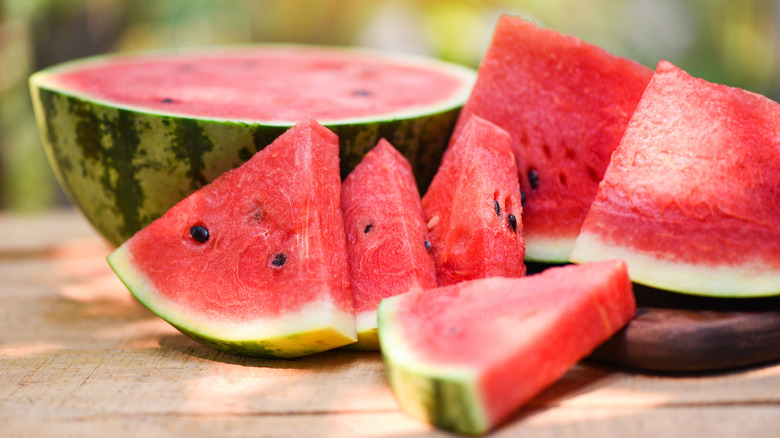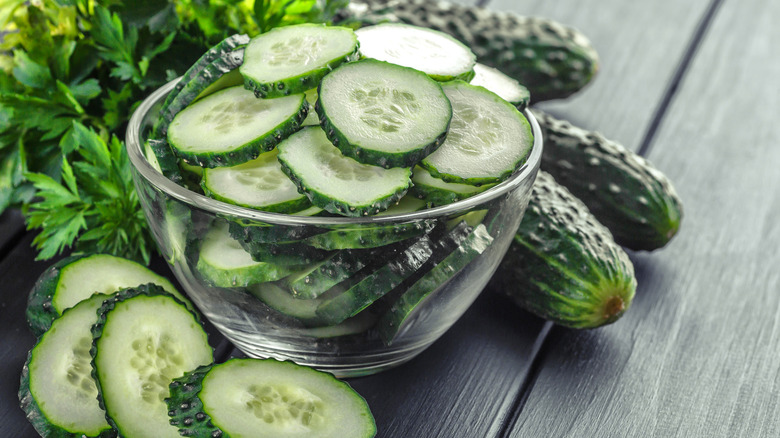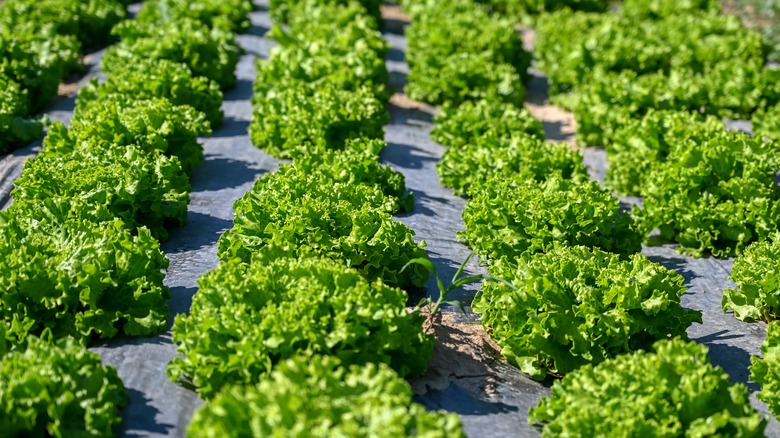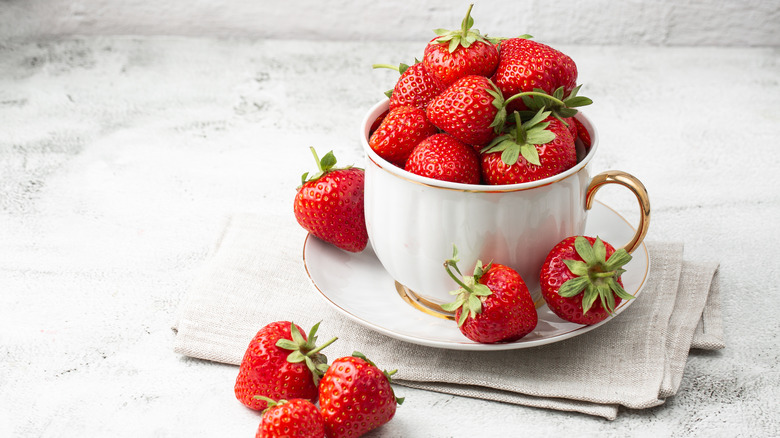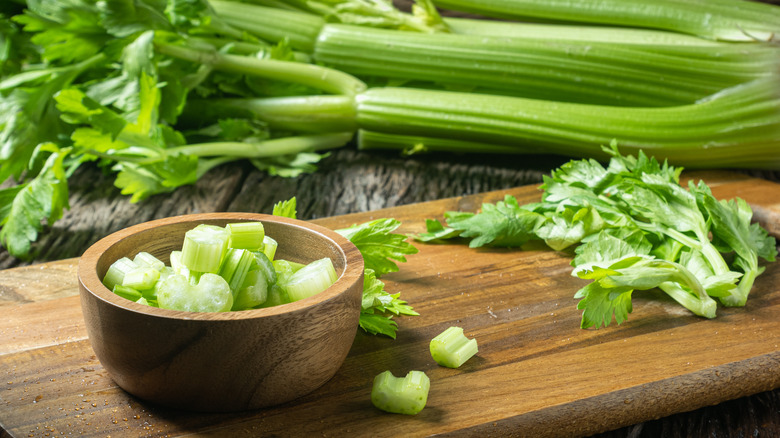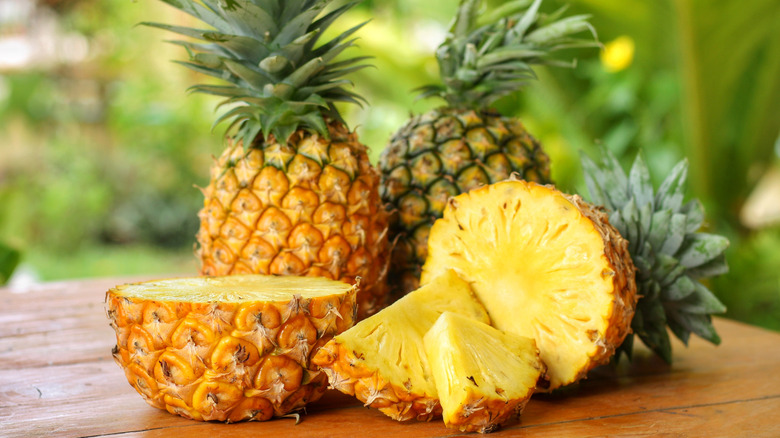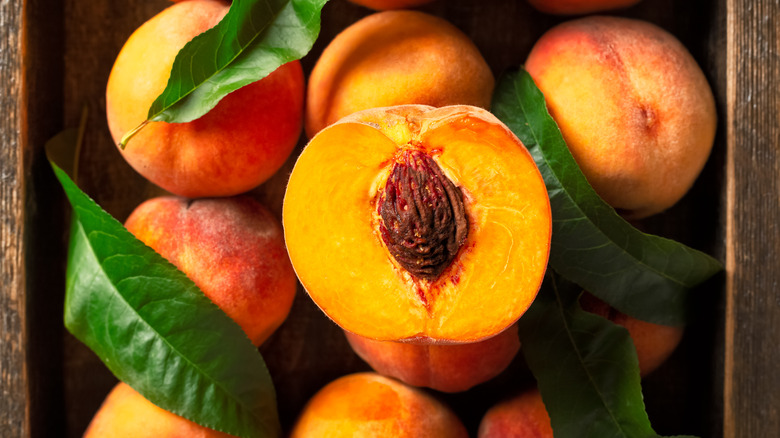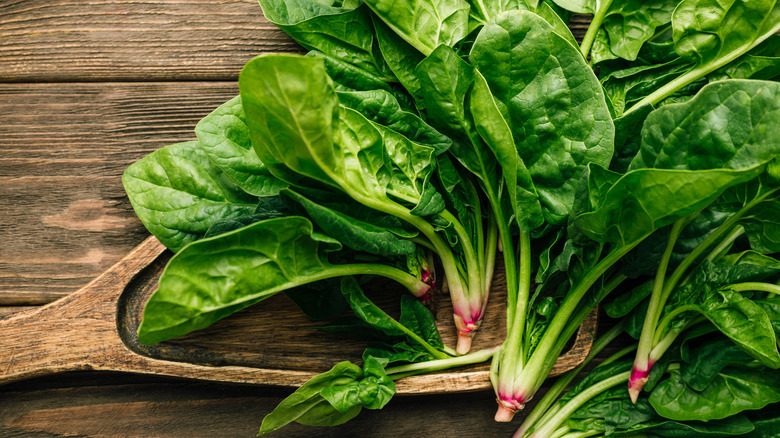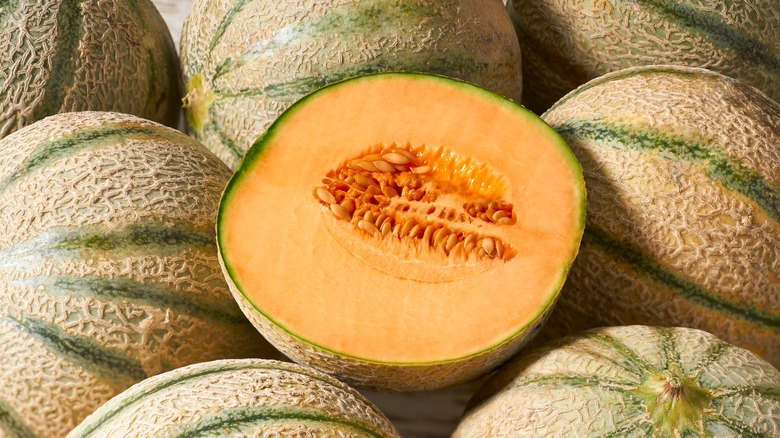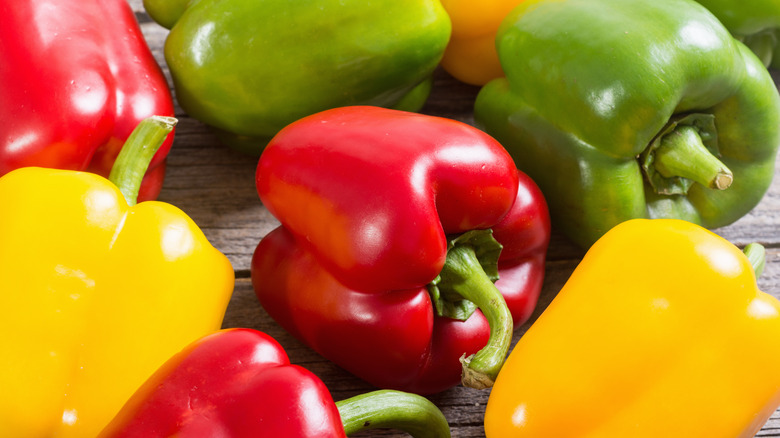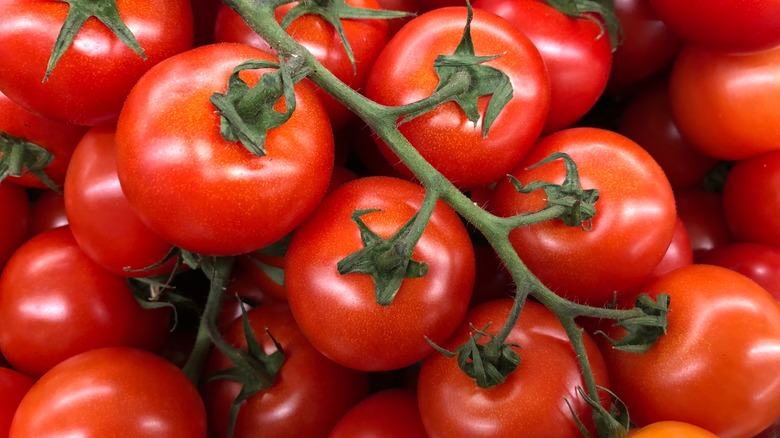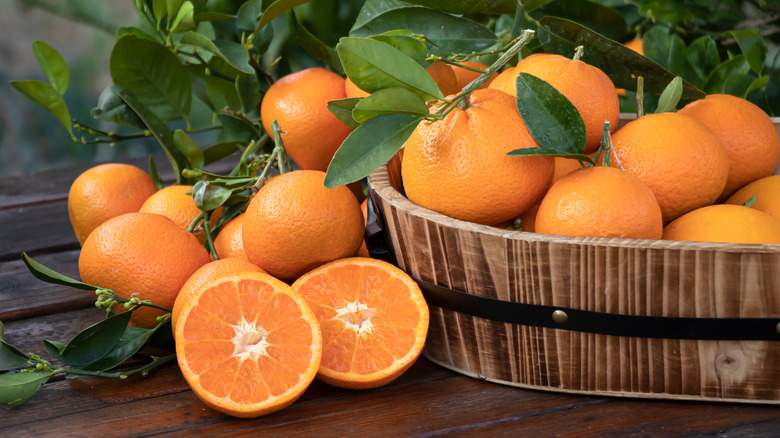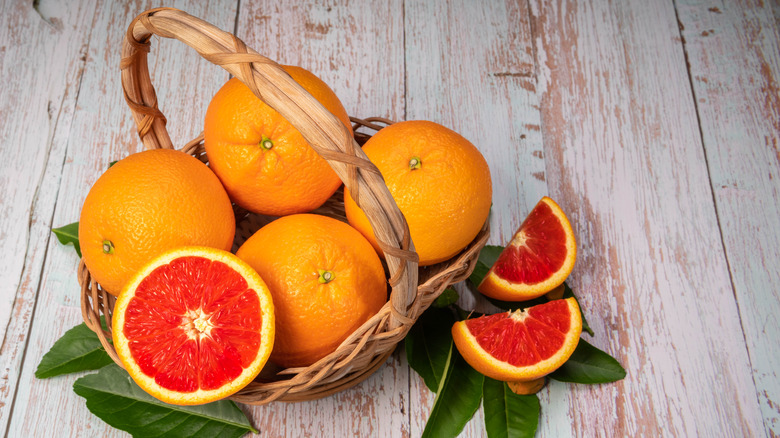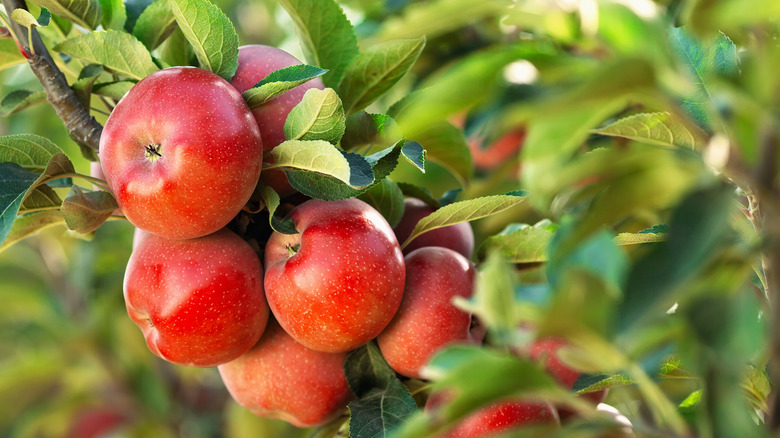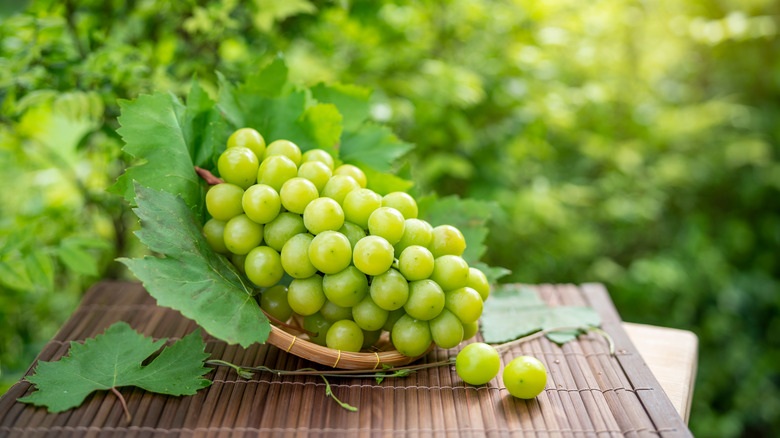15 Fruits And Veggies That Can Help You Stay Hydrated
You may be surprised to learn that eating certain fruits and vegetables can actually help to keep you hydrated throughout the day. Because fruits and veggies contain a large amount of water, they can replace some of the water your bodies uses to function. So, if you're not a fan of drinking a big glass of water several times a day, eating certain fresh foods can help to lower the amount of water you need to sip on.
According to Mayo Clinic, people should consume between 11.5 and 15.5 cups of water on a daily basis depending on their size and activity levels. So how can you hit your daily water goal? Well, since the recommended amount includes the water you get from food sources, one way to get there faster is to eat the right foods. You won't need to worry too much about overdoing it with fruits and veggies since LiveStrong notes that foods with a high water density tend to be low-calorie. Read on to learn about some of the best fruit and vegetable options for boosting your water intake.
1. Watermelon
It shouldn't come as a shock that this quintessential summertime fruit contains a lot of water. In fact, watermelons contain more than 90% water, according to Healthline. This helps to explain why they weigh so much, though it won't comfort you to know that a lot of what you're paying for when you buy them by the pound is just water. Even so, that water has plenty of benefits.
Eating watermelon is pleasant enough, but it can also be great to use in recipes and smoothies. Its subtly sweet flavor goes well with herbs like mint, or you can blend it into a margarita recipe. There are dozens of amazing ways to use up a watermelon, including popsicles, salads, marinades, and salsa. This versatile fruit is a great choice for getting a little extra water in your system. Plus, if your kids avoid drinking water, try feeding them sweet watermelon as an easy way to stay hydrated.
2. Cucumber
Though technically a fruit, cucumbers are typically used as vegetables thanks to their crisp texture that's perfect for salads. As well, they have regularly been used in a number of health products over the years. Spas often offer cucumber water, and we've all seen people wear slices over their eyes. Why is that? Well, cucumbers contain about 95% water, as Verywell Fit reports, which means they provide extra hydration to the body, whether you absorb it through your skin or by eating them.
The peel and seeds contain the most nutrients, according to Live Science, but the high water content is essential for health as well. Eating cucumbers will help you ingest the water you need to stay healthy, while the vitamin-rich parts components offer even more benefits. All around, this is one vegetable you're going to want to eat more of. Whether you chop it up in a salad or eat it whole, cucumbers are great for hydration. You might want to set aside a couple of slices to replenish your eyes while you're at it!
3. Lettuce
If you're eating a salad, you're actually helping to restore the water in your body. Each crunchy bite of lettuce contains a significant amount of water, though the specifics depend on the type of lettuce. Red leaf lettuce, for example, contains about 95% water according to the USDA, and some other varieties can contain even more. The signature refreshing crunch of iceberg lettuce should indicate that this variety is high in water, and in fact, Cooking Light lists the content at 96%.
With such high levels of water, you'll want to keep using lettuce as a base for your salads to provide your body with water replenishment. For many people, the middle of the day is when we start to feel our energy running out. However, it's not necessarily because of hunger or lack of sleep, and Mayo Clinic lists fatigue as a possible sign of dehydration. So if you're feeling low on energy, it might be time to drink a glass of water or at least whip up a nourishing salad.
4. Strawberries
Strawberries are among the more popular fruits in the U.S., outranking every other berry, according to data from the USDA. Not only are they delicious and often affordable when in season, but they have many great health benefits too. Taste of Home says that strawberries can aid digestion, keep blood pressure at a healthy level, and even contribute to heart health. And, of course, they contain a lot of water too.
The USDA indicates that strawberries are about 91% water on average, making them one of the best fruits to eat if you want to stay hydrated. Their high water content gives strawberries their juicy texture, and their sweet potent flavor makes them an attractive option as a health food. Their one downside is that they don't stay fresh as long as other fruits, like grapes or apples. Berries need to be eaten within a matter of days, but given how yummy they are, that shouldn't be a problem.
5. Celery
For a while, celery juice was a popular health craze among celebrities. According to Well+Good, celery juice may have anti-inflammatory properties and can even help with weight loss. Whether or not you experience those effects, one benefit should be true for everyone: Celery can help keep you hydrated. Since it is made up of more than 95% water according to the USDA, celery is a great source for rehydrating. And this is true whether you eat it raw or drink the juice.
Healthline suggests keeping in mind that celery loses much of its fiber content after being juiced since the pulp is thrown out. So, eating raw celery can be ideal if you want to get the nutritious benefits that fiber can provide. Granted, chewing on celery can feel like an Olympic sport after a while, but you can make it a little easier by dipping it in hummus or peanut butter. When you see celery on the menu, even as a garnish, you may want to consider eating it for some extra hydration. Even the celery stalk in your Bloody Mary counts!
6. Pineapple
This tasty tropical fruit is sweet enough to be compared to candy and luckily, it offers a boost to your health as well. Data from the USDA shows that pineapples are made up of about 86% water, so they can hydrate you while you snack on them. Their high water content can be somewhat explained by the fruit's growing process.
Pineapple plants can take up to two years to grow one fruit, and during this time, much of the water is absorbed into the thick leaves, according to Better Homes and Gardens. This technique of storing water ensures that the plant will be able to grow fruit and stay alive in case of drought. So next time you're enjoying some sliced pineapple, take a moment to appreciate it. Not only did it take a long time for the fruit to grow, but it is also doing a good job of keeping you healthy and hydrated.
7. Peaches
Georgia's state fruit has a secret power: It's keeping you hydrated thanks to its high water content, and on a hot day in the South, this extra characteristic can be really useful. Yellow peaches are made up of at least 87% water, according to the USDA. Staying hydrated has benefits that go beyond just feeling better, and Harvard's School of Public Health lists body temperature regulation, maintaining proper joint and organ function, and even better sleep quality as some examples. All this can be achieved by making sure your body has the right amount of water coming in on a daily basis.
With all of the upsides to hydration, you have one more reason to eat your fruits and veggies. If you're a fan of sweet juicy peaches, these are a great way to boost your water intake. Of course, if you're turned off by peach fuzz, nectarines are a good option with a similar flavor and water content (via USDA).
8. Spinach
If you've ever wondered why spinach shrinks so drastically when cooked, the answer is water loss. The USDA reports that the leafy green contains more than 90% water, and according to BBC Good Food, the water escapes and either evaporates or sits in the pan as it cooks. This water separation causes the leaves to shrivel, yielding a smaller serving than you might anticipate. However, eating fresh spinach will give you the added benefit of hydration on top of its admirable nutrition profile.
Of course, it's harder to eat a whole bag of fresh spinach than a small serving of cooked spinach, but there are many ways to serve it. Add the leafy greens to salads or use them as a substitute for lettuce on burgers and sandwiches. Fresh spinach tends to have a firm texture and the taste is pleasant as well. If you're hesitant, try throwing a few leaves into your next smoothie. You'll be surprised to find that you can barely taste it alongside the sweet fruit flavors. However you incorporate spinach, you're making a good decision. Popeye would be proud.
9. Cantaloupe
As with other melons, cantaloupe needs a lot of water to grow and ends up retaining a good deal of it once ripe. According to Delishably, heavier cantaloupes are ideal, and due to their high water density, they offer a great source of hydration. The USDA indicates that they contain around 90% water, plus they have a deliciously sweet taste that makes them a welcome snack.
Real Simple suggests keeping your cantaloupe refrigerated once you bring it home so that it lasts several days. You can slice it up to eat by hand, or dice it and use a fork. Whichever way you choose to prepare the melon, your body will get a boost of nutrients. Mayo Clinic notes that not only do cantaloupes contain lots of vitamins A and C, but they are low calorie too. And of course, they can help keep you hydrated thanks to all of the water they have stored inside.
10. Bell peppers
In case you didn't know, the bell pepper is actually one of several foods that are assumed to be vegetables but actually fall under the fruit category, as Business Insider explains. Another hidden truth is that sweet bell peppers contain between 90% and 95% water, according to the USDA. The juicy crunch you get when biting into a bell pepper is largely due to its water content, and its unique texture and subtle flavors make a great addition to salads.
Taste of Home describes how to differentiate between male peppers that have three lobes and are better for baking, versus female peppers with four lobes, which tend to be sweeter and juicier. This suggests that female peppers are better for eating raw, so if you're planning on getting your daily water intake by eating peppers, check for four lobes at the base. You can also pick up some dips like ranch or hummus if you want to have a more filling snack.
11. Tomatoes
Tomatoes are the second most popular vegetable (though botanically categorized as fruits, as per Britannica), according to 2019 data from the USDA. On average, Americans eat more than 30 pounds per person per year, which is great since they carry lots of water. Each juicy tomato can contain up to 95% water, as indicated by data from the USDA, which means they are a powerful hydration option.
Tomatoes can be consumed in a range of ways, and the simplest preparation is raw. They are delicious whether you choose to snack on cherry tomatoes, mix them into a salad, or serve them as a sandwich topping. Then there's tomato juice, which Well+Good says retains a high water content, making it a solid option if you're bored of plain water. The taste isn't exactly the same as a fresh tomato, but a lot of people love it. Basically, there are lots of ways to get some extra hydration from tomatoes. Just include them in your diet however works best for you and enjoy the benefits.
12. Oranges
The flavor of oranges is well-loved, and they're easy to incorporate into numerous recipes. From orange chicken to orange chocolate loaf cake, the citrus flavor works for many kinds of dishes. Orange juice is also the most popular juice in the U.S. (via USDA) which is good news for Americans, as it helps them meet their hydration needs. The USDA data reports that oranges contain approximately 86% water, making them one of the best fruits for staying hydrated.
You can eat oranges raw or juice them — either way, you will get most of the water content they have to offer. You can also peel the fruit and blend the sections into a smoothie so that you get the benefits from the fiber. Since oranges tend to be available year-round, they're a good fruit to get in the habit of eating. Plus, they're pretty portable and their tough skin makes them a nice option for lunch bags. Not to mention, oranges have a long shelf-life for fruit, lasting several days on the counter and even longer if refrigerated.
13. Grapefruit
If you love the taste of grapefruit, be it bitter or sour, you'll love knowing that each one you eat is also helping to keep you hydrated. Indeed, according to the USDA, you can expect your grapefruit to contain more than 90% water. Like other citrus fruits, the juicy texture is in part due to its high water content. You may notice that citrus tends to squirt or leave juice behind when you cut it, which should be expected since it is mostly liquid.
Apart from hydration, grapefruits are known to provide other benefits. BBC Good Food says it contains potassium, antioxidants, and vitamins, plus it can assist in weight loss as a low-calorie food. Now, if you're someone who puts sugar on your grapefruit to make it sweet, you may not be getting as much of a nutritional benefit, at least calorically. But adding sugar isn't going to cancel out the hydrating characteristic.
14. Apples
Although there are more than 7,500 varieties of apples and more than 2,500 types in the U.S. alone, according to the University of Illinois, you can count on the fact that all of them will offer at least some hydration benefit. The USDA studied several of the most popular commercial varieties, including Red Delicious and Granny Smith, finding that on average they held about 86% water.
If you're shocked by how many types of apples there are, you may find it even more surprising that there used to be a lot more. Mother Jones says thousands of varieties grew in the U.S. before certain types were selected and promoted by the apple industry, leaving the rest behind.
The staying power of this fruit is overall positive since it is hydrating and contains useful vitamins. Apples are considered by some to be the ultimate healthy snack, as indicated by the saying, "An apple a day keeps the doctor away." Keep in mind that apples will last for weeks in the refrigerator, so unless you plan on eating them quickly, you may want to consider keeping them cooled.
15. Grapes
In addition to being a delicious treat, the high water content of grapes makes them a healthy choice too. The USDA says that grapes have more than 80% water, and since they're available for most of the year, they're perfect to keep on hand as a hydration boost.
Grapes are easily portable and hold up fairly well due to their tough skin — just pop them in a container to avoid squishing them. Plus, on hot days when you might risk dehydration, grapes can be a great option to munch on. You can also freeze them ahead of time so that by the time you're ready to eat them, they'll still be cool but not rock-hard. Kids tend to like grapes as a snack, so they work well for lunch-boxes too. This is especially useful if your child refuses to drink water. Adults can also enjoy the hydrating benefit of grapes and get even closer to hitting their daily water intake goals by eating a bunch.

